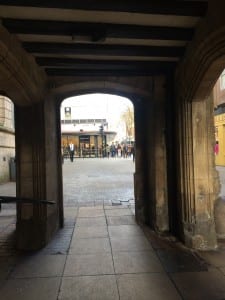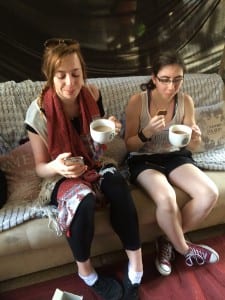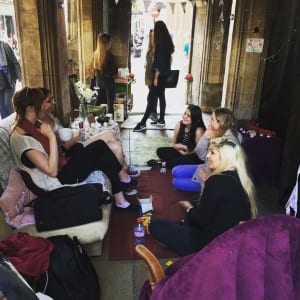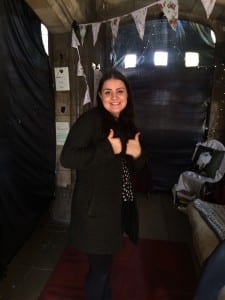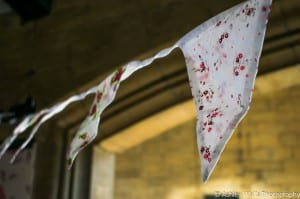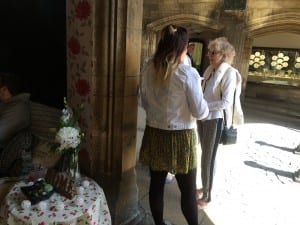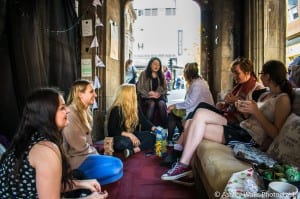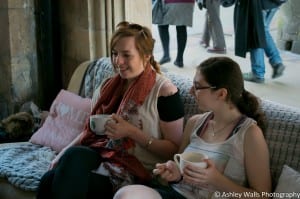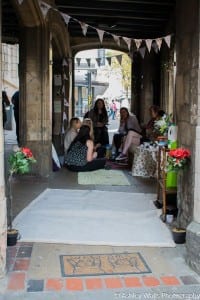There’s Non- place like home.
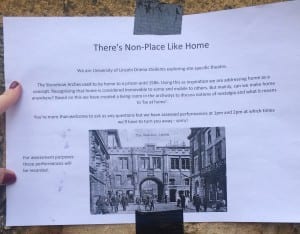
A photo of the small framing statement that we attached to the columns of Lincoln stone-bow arches. (D’Arcy, 2016)
Framing statement:
“If a place can be defined as relational, historical or concerned with identity, then a space which can-not be defined as relational, historical or concerned with identity will be a non-place” (Pearson, 2010). My group and I’s chosen site used to be a place of history, kings and queens have walked through the stone- bow arches of Lincoln. They were specifically placed in the middle of the high street by the Romans in the second century as a central meeting place.
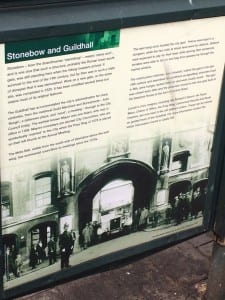 one of the historic signs that are placed within Lincoln high street, explaining the importance and history of the stone bow arches. (D’Arcy,2016)
one of the historic signs that are placed within Lincoln high street, explaining the importance and history of the stone bow arches. (D’Arcy,2016)
Lincoln’s stone bow arches now stand as a non- place. Mark Ague describes a non- place as a place of transit (Augé and Auge, 2009). Over time this is what the stone bow arches have become. With the influence of Mark Ague, my group and I decided we wanted to turn a non-place into a place for our final site specific performance. When looking for potential performance space we noticed that homeless people would gather and take shelter underneath the stone bow arches. For these people the arches are a place and provide them with a temporary home. Putting these two ideas together, myself and my group decided that we were going to change the arches into a place, and that place being a home. To do this we selected a specific arch, and thought about what it is to create a domestic home setting.
This is a photo of the arch we selected for our site specific performance (D’Arcy,2016).
we covered the openings too our chosen arch in black cloth to create a more enclosed space, we then brought in a sofa, which we felt was the key feature to any domestic living room. We placed rugs on the floor, and attached wallpaper on to the small beams that hold up the archways. Furthermore battery powered lights were used all around the space, to make the space feel safe and comfortable for the audience. Using props and attention to detail we transformed the stone bow arches into a domestic living room setting.
a video, showing the process of creating our home setting ( Lomas, 2016)
The intention of our performance was to make the audience think. To think about what it is to make a home, to think about what homeless people class as their home. To think about whether home is a concept or a place. When we invited audience into our piece, this is the type of conversation that we wanted to stem, and we succeeded within doing this.
Upon arrival, the audience were offered a cup of tea. This drink being the most popular when we asking the public prior to the performance ‘what drink makes you think of home?’ as well as this a complementary biscuit was given. Without acting our aim was to make the audience to feel that we were welcoming, and that they were comfortable within are company. The duration of the performance was a total of seven hours including set up time. Even though it was not planned, the audience participated within conversation from the moment we began to set up the space. Curiosity led many audience members over, and when describing our intentions many people were happy to have these conversations with us. 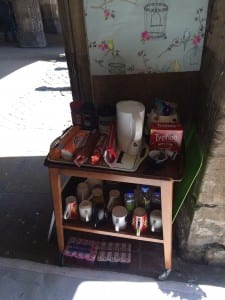
A photo of refreshments the audience were offered when taking part in our site specific piece (D’Arcy, 2016).
Analysis of process:
“place is space in which important words have been spoken which have established identity, defined vocation and envisioned destiny. Place is space in which vows have been exchanged, promises have been made and demands have been issued.” (Pearson, 2010).
We found our site before finding our story, myself and my group became interested with the stone bow arches from day one, allocated around Lincoln are sign post describing the history of the stone bow arches. When looking into the history of the arches we saw that placed underneath used to be prison cells. “The East Wing once contained the City prison and a kitchen, but in 1586 the City bought the house next door and used it as a prison for many years. It can be seen in nineteenth century paintings and prints by Augustus Pugin and others in the Guildhall and Central Library” (solutions, 2007). Furthermore, the arches were a popular place for gatherings because of their central location. However now are just a place of transit, we know this from observing the arches, myself and group sat in our space, watching and listening to the passers-by, noticing that no one stopped within the space, just walked straight through.
A video taken above the stone bow arches. a transit of people walking straight through (D’Arcy, 2016).
Looking further into the history of the Stone bow arches and discovering the prison that used to lie below, myself and my group contemplated on creating a site specific performance based on the prison. “site specific performance can be especially powerful as a vehicle for a remembering and forming a community for at least two reasons. First, its location can work as a potent mnemonic trigger, helping to evoke specific past times”( Pearson, 2010). We wanted to create a performance that would tell the history of the stone bow arches, using influences from mike Pearson’s book site- specific performance and the idea of triggering memories of the audience.
However, after a group discussion we came to a conclusion that the audience in the high street are probably not aware of the past prison, and this was an issue we needed to overcome due to wanting to get our audience involved within the performance.
Thinking of ways to connect to the audience, we looked into the work of Adrian Howell, and his idea of confessional exchange with audience members. “Adrian Howells has made a significant contribution to this confessional performance landscape, creating and touring performances in which he confides in strangers hoping, in turn, that they will share details with him” (Heddon and Howells, 2011). As a group we wanted to incorporate the work of Adrian within our piece, asking our audience questions in the hope of in depth answers. With Adrian’s video you can see that he puts on a persona and talks to his audience within a salon while massaging their head, he calls this process confessional exchange. Using the idea of confessional exchange, this changed our initial idea of using our site to represent a prison; instead we wanted to create a setting where we could get information from our audience using confessional exchange. Which led us to the idea of home, and creating a home in the high-street. Still using the idea of place and non place and the influence of Adrian Howell this developed our idea into inviting people into our makeshift home, offering them something in return of answering our questions.
Another site-specific performer that interested myself and my group is Sophie Calle, with one of her most popular pieces suite venitienne which initials her following around a random man, even to the point where he got the plane to Venice . “In Suite Venitienne, the artist exposes someone else, by tracking him through his journey in Venice. She documents all the man’s moves throughout his stay by photographing, mapping and writing all the precise details of his actions. In the end, we can say that she is the one who is more exposed in this work. She exposes herself through a weird habit which is following strangers throughout the city. The main interest in the book is not what Henri B. does during his stay in Venice but mostly why does Sophie Calle follows a stranger for days in a foreign country.” (champsaur, 2011).
Sophie Calle’s reasoning for doing this was to connect herself to the city that she was in. Incorporating Sophie into our work we decided to base our questions around the idea of home, asking the audience about Lincoln and if they consider it there home. Connecting ourselves to the city with the representation of Lincoln from audience members. We planned on taking photos of the audience that came into our domestic home setting, hanging these photos across the space, making them a part of our ‘Lincoln family’. This related closely to another practitioner we became interested in, Christian Nold and his performance piece of ‘Emotional cartography’. “In structured workshops, participants re-explore their local area with the use of a unique device invented by Christian Nold which records the wearer’s Galvanic Skin Response (GSR), which is a simple indicator of emotional arousal in conjunction with their geographical location” (Nold,2009). However, instead of physically mapping the people of Lincoln, we are using a form of mental mapping, gathering the audiences emotional feelings towards Lincoln and home.
This idea changed when myself and my group came to realise that our piece would depend completely on audience members and them giving us detailed answers. To test out ideas we went into the high-street with a recording device and a set of questions that we had put together. These questions consisting of: do you think of Lincoln as your home? Where is your favorite place to be in Lincoln? And What makes you think of home? At first it was a challenge to get the attention of the public a lot of people purposefully ignored us, others said they had no time. This continued until we came up with alternative way to get the attention of the public, again using the idea of Adrian Howell and how he would wash and massage a persons head in the salon. We offered out biscuits in the street for the exchange of answering some questions and that was effective. However, as predicted it was difficult trying to get in depth answers from the public, even when asking them to expand. From this we gathered that by offering the audience something it made them more engaged with what we were trying to do. But due to the bland responses the audience gave we decided against this idea.
At this point my group and I went in the opposite direction. We were suggested to look at On the Scent by Curious (2003). This made us think about making our performance choreographed and scripted so the whole group had something to do throughout the entirety. Going back to the idea of the old prison, we decided to mix this with our new concept; the new idea was to make the audience feel trapped within our home, like prisoners are within a prison.
With inspiration from John Newling and his site specific performance using lights to make a place feel safe, we wanted to adapt this idea within our prison theme. Including binaries such as safe and unsafe, light and darkness, free and trapped, comfortable and uncomfortable. All of these relating back to a prison cell. With this idea we created a script, giving ourselves roles within the domestic living room setting. I assigned myself with the role of a cleaner, within this role i made the audience member feel uncomfortable by repeatedly asking them to stand up so that I could clean underneath them. Each member of the group had a specific set of questions to ask the audience member, my questions being, are you comfortable? And could you stand for me? Other members of my group worked around the other binaries by doing things such as getting close to the audience making them feel trapped and awkward and turning on and off the lights. According to john Newling lights represent safety. We showed this performance to Conan and Steve, however, the feedback we received from this was that we had over complicated things. Even though the ideas we had appeared effective on paper they didn’t work well when having an audience. we also got told that we were acting within our performance, which is something that Steve and Conan preferred we didn’t.
This took my group back to the drawing board, to set our heads on to one simple and solid idea. We all had a clear idea that we wanted to stick to our idea of home, working around the concept of place and non-place. We still wanted to invite the audience members in and talk to them but we decided on not relating the performance itself to the prison. We wanted our performance to be natural. we established that the process of making a home in the high street was a performance in itself, sticking with the influence of Adrian Howell we invited audience in to simply speak about the concept of home, and what a home is, offering our audience a cup of tea and a biscuit. This idea still related to our site, working with place and non place, using the idea that prison is a temporary home without specifically mentioning it and relating our performance to the numerous homeless people that take shelter within the stone bow arches.
Performance evaluation :
The performance began at 10 am where we began to build our home, passers-by made comments such as ‘are you guys moving in?’ and in a sense we were. We began to make the space that we had into a home. Concentrating closely on the small details such as candles and cushions to make sure that our space looked authentic and felt comfortable.
Our aim was to make our site look inviting and comfortable to draw in the audience. Drawing in the audience was important to us, without the audience we would not have fully achieved turning our non- place into a place. The overall set up of the domestic living room setting drew in lots of attention including a Lincoln photographer who’s name I didn’t catch, however he was very excited by what we were creating. Another man came in questioning what we were doing and after conversing with him it turned out he himself was one of the homeless men that took shelter underneath the stone bow arches. He told us that a home doesn’t have to be where your things are, or in a house at all. A phrase that attached with myself and the rest of my group was when he said “home is where the heart is” the conversation with this man helped us to talk to other audience members with this man in mind who doesn’t have a permanent ‘home’.
Audience members happily came in to our space after reading our small framing statement which we stuck to the sides of the columns. Even though it was an open space it was strange to see that all participating audience members asked permission before coming into the space, as if it was our actual home. When the audience came in we made them comfortable gave them a cup of hot tea and a biscuit. The conversations that came from our audience members was all incredibly different and interesting. Everyone had a different idea to what they thought was home.
During our process I began to question myself what I thought of the word home, and if it was actually just a concept. My personal opinion being that home is a place that I feel safe and comfortable.
The final outcome of the performance allowed me to indulge into a new way of performing, using my knowledge on the history of my site and theorist to create a performance/ installation which made the audience think about home in detail. Something that they most likely haven’t done before. As well as this I began to think about these concepts even as myself the artist who had come up with the idea. Opening my mind to other peoples opinions and thoughts. Overall we succeeded in changing a non – place into a place. I know this because one audience participant said ‘ ‘ i am always going to remember how lovely this looked when i walk past in future’.
videos by Holly Lomas (2016)
photos from Hannah D’Arcy and Ashley Walls.(2016)
citations
Auge, M. (1995) Non-places: Introduction to an Anthropology of Supermodernity. Translated from French by John Howe. London: Verso Books.
Calle, S. (2015) Suite Venitienne. Los Angeles: Siglio Press.
Calvert, O., D’Arcy, H., Elmer, F., Lomas, H. and Soyza, R. (2016) There’s Non-Place Like Home. [performance art] Lincoln: High Street, 5 May.
Curious (2003) On The Scent. [performance art] Birmingham: FIERCE! Festival, 4 June.
D’Arcy. H. (2016) There’s non place like home: Stonebow Arches
Heddon, D. and Howells, A. (2011) From Talking to Silence: A Confessional Journey. PAJ – A Journal of Performance and Art, 33 (1) 1-12.
Heddon, D. and Howells, A. (2011) ‘From salon Adrienne to the garden of Adrian: A journey of revelation’, PAJ: A Journal of Performance and Art, 33(331), pp. 1–12.
Howells, A. (2005) Salon Adrienne. [performance art] London: Battersea Arts Centre, 3 October
Lomas, H. (2016) There’s Non-Place Like Home.Lincoln: Stone Bow Arches.
